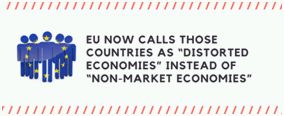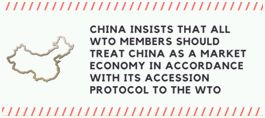On 4 December, the Council approved new rules to help protect the EU against unfair trade practices. The EU Regulation 2017/2321 on the new antidumping methodology was published in the Official Journal on 19 December 2017 and thus entered into force on 20 December 20171.

The new legal methodology removes the former distinction between market and non-market economies for calculating dumping while aiming at maintaining the same level of protection for European producers. As such, the EU Regulation contains a new paragraph 6a added to Article 2 of the Basic Anti-Dumping Regulation, whereby a new methodology for establishing normal value is introduced in case of "significant distortions"2 in the market of the exporting country. The Commission will now need to prove the existence of a "significant market distortion" between a product's sale price and its production cost. On that basis, it will be allowed to set a price for the product by referring for example to the price of the good in a country with a similar level of economic development or to relevant undistorted prices and benchmarks. Consequently the use of domestic prices and costs in that country becomes inappropriate. In other words, the new EU methodology adopts a country-neutral approach by repealing prior distinction between market and non-market economies and it applies to all countries where the EU investigating authority considers that "significant distortions" exist.
Even though the Commission's approach is said to be
"country-neutral", the main rationale of the new
anti-dumping and anti-subsidy legislation actually remains to be
the fight against China's trade dumping. The EU was not eager
to recognise China as a market economy since under the existing
rules anti-dumping investigators were calculating a Chinese
product's undistorted price by using proxies from similar
countries - instead of relying on domestic prices. The methodology
of 'analogue country' usually resulted in imposing higher
anti-dumping duties on Chinese goods. The Commission originally
proposed to revise its anti-dumping and anti-subsidy rules in
November 2016, just before the 15th anniversary of China's
accession to the WTO. The end of year 2016 meant that China could
not be treated anymore as a non-market economy for the purposes of
the antidumping investigations. On that basis, the Chinese
Government insists that all WTO members should treat China as a
market economy as from December 11, 2016.  Along that line, China also launched disputes at
the WTO against the EU and the US regarding both countries'
regulations and measures related to price comparison methodologies
that pertained to the determination of normal value for
"non-market economy" countries in anti-dumping
proceedings involving products from China3.
Along that line, China also launched disputes at
the WTO against the EU and the US regarding both countries'
regulations and measures related to price comparison methodologies
that pertained to the determination of normal value for
"non-market economy" countries in anti-dumping
proceedings involving products from China3.

The new methodology implemented by the EU is both 'country neutral'- and is targeted towards catching the so-called 'substantial market distortions' generated by state intervention. In such cases where the intervention is likely, the new EU methodology clearly lays down principles on how to construct an undistorted value by way of using benchmarks or data from similar countries. The novel and innovative nature of the methodology lies in the introduction of international social (labour) and environmental standards into the trade defence instruments, a matter that was primarily of concern to and asked by the Parliament. Recital 4 stipulates that in the assessment of the existence of significant distortions, "relevant international standards, including core conventions of the International Labour Organization (ILO) and relevant multilateral environmental conventions, should be taken into account, where appropriate". However, this proviso does not seem to have found its reflection in Article 2 (6a)(b) of the new Basic Anti-Dumping Regulation which falls short of laying down an obligation to include social and environmental standards into the list of element that need to be taken into account while assessing the existence of significant distortion.
In order to ensure the WTO consistency of the new methodology, such provisions will essentially be applicable to the selection of a third country in the process of establishing the normal value. Accordingly, the Commission will use the benchmark of the country that is "as close as possible to (EU) standards". While selecting the third country, the requirement to seek for similarity at the level of economic development will be respected. In order to ensure this standard, the data from the third country which will be placed in the report needs to be made available to the public with specific bearing to the inputs under investigation. To the extent the domestic costs in the exporting country are not distorted by state interference, the Commission will use them for the calculation of the normal value.

Article 11(3) and 11(4) of the new Basic Anti-Dumping Regulation lays down a limitation to the application of the new methodology to cases initiated as its entry into force only and stipulates that 'Where existing anti-dumping measures are based on a normal value calculated pursuant to the Article 2(7) as it was in force on 19 December 2017, the methodology laid down in Article 2(1) to (6a) shall replace the original methodology used for the determination of the normal value only from the date on which the first expiry review of those measures, after 19 December 2017, is initiated. In accordance with Article 11(2), those measures shall remain in force pending the outcome of the review.' As such, in reviews of existing trade defence measures in place, the new methodology will only be applied as from the time of the next scheduled expiry review of those measures. In addition, the legislation makes clear that without other changes in circumstances, existing measures should not be reviewed just because a new calculation methodology is adopted.
Within the framework of the new methodology, the burden
of proof related to the demonstration of the market
distortion, will be shifting to the complainant EU industry and the
EU Commission. Under the new system, the Commission is entrusted to
draft specific reports on countries or sectors describing
distortions. In line with the existing practice, the EU firms will
continue to file complaints, but differently from what is already
provided, they will now be able to use the Commission's reports
as a supportive element for their case.  As such, European companies will be entitled to
count on the detailed reports produced by the Commission and
defining the specific market conditions in a country and sector.
These reports will essentially consist of technical and factual
assessments that will be made public and will serve the purpose of
accomplishing the task of describing the distortions in addition to
other means used for that purpose. Consequently, both these reports
and any other information related to possible distortions are
likely to be part of a potential antidumping investigation
targeting that country or sector. The fact that the reports will
contain technical assessments and be placed on the case file in
every investigation would give them the value of a piece of
evidence and thus make them subject to potential challenge by the
parties that present a concern related to the investigation. Since
the degree to which state interferes in a given economy may change,
the reports will be subject to regular updates as to reflect those
potential changes.
As such, European companies will be entitled to
count on the detailed reports produced by the Commission and
defining the specific market conditions in a country and sector.
These reports will essentially consist of technical and factual
assessments that will be made public and will serve the purpose of
accomplishing the task of describing the distortions in addition to
other means used for that purpose. Consequently, both these reports
and any other information related to possible distortions are
likely to be part of a potential antidumping investigation
targeting that country or sector. The fact that the reports will
contain technical assessments and be placed on the case file in
every investigation would give them the value of a piece of
evidence and thus make them subject to potential challenge by the
parties that present a concern related to the investigation. Since
the degree to which state interferes in a given economy may change,
the reports will be subject to regular updates as to reflect those
potential changes.
The first report concerns China4 and has already been made public. The Commission linked its choice of China as the first country to report on, to the largest proportion it occupies within the total number of EU's anti-dumping investigations and trade defence measures. The Commission also signalled that the next country report will concern Russian Federation due to "its relative importance in the EU's anti-dumping activity, as well as indications that there may be distortions related to government interventions in the economy"5.

Apart from China, a number of other WTO Members, including Russian Federation, are also sceptical and critical about the new Regulation which will be applied on industries like steel, e-bikes, solar panels or tyres for heavy duty vehicles among others and expressed their concerns at the WTO meetings. One of the main issues for criticism is the complex new 'country neutral' methodology. Although the Commission argues that it adopted an approach that both addresses European producers' demands to be protected and honour EU's commitments under the WTO, some WTO Members direct their criticism towards the EU's discretionary power to apply the 'significant distortions' criteria coupled with social and environmental standards. Following the entry into force of the EU's new Anti-Dumping Regulation and its first Report, China's Ministry of Commerce reacted by arguing that the new methodology actually is a continuation of the old methodology and thus violates the EU's WTO obligations for the very same reasons that the previous methodology did and which China challenged at the WTO dispute settlement system.6
In conclusion, although the new Regulation and methodology formally puts an end to the distinction between the market and non-market economies, one could well argue that the Commission's new approach to calculate the normal value in anti-dumping investigations is geared towards targeting China and few countries, including Russian Federation that were dealt with by the Commission in the past as non-market economies. As a matter of fact, the way in which the EU now calls those countries as "distorted economies" instead of "non-market economies", does not appear to bring along much difference and is questioned by various WTO Members. Moreover, the prospect of adding new standards on labour and environment into the calculation of the normal value without providing any clear guidance on how to apply those criteria, adds another layer and source of criticism. Consequently, the first year into the application of the new methodology and the new Regulation will be subject to a critical scrutiny by EU's trading partners and tested as such, while keeping an eye on the outcome of the China's pending WTO disputes against the EU and the US over their price comparison methodologies.
Footnotes
1. Regulation (EU) 2017/2321 of the European Parliament and of the Council of 12 December 2017 amending Regulation (EU) 2016/1036 on protection against dumped imports from countries not members of the European Union and Regulation (EU) 2016/1037 on protection against subsidized imports from countries not members of the European Union.
2. According to the Regulation, significant distortions are "distortions which occur when reported prices or costs, including the costs of raw materials and energy, are not the result of free market forces because they are affected by substantial government intervention".
3. See WTO/DS515/15 United States — Measures Related to Price Comparison Methodologies, and WTO/DS516/11 European Union — Measures Related to Price Comparison Methodologies.
4. Commission Staff Working Document On Significant Distortions In The Economy Of The People's Republic Of China For The Purposes Of Trade Defence Investigations, SWD(2017) 483 final/2, Brussels, 20.12.2017.
5. EU Commission, Fact-Sheet: "The EU's new trade defence rules and first country report", 20 December 2017.
6. See MOFCOM Spokesman Comments on the EU's Release of the Amendments to the New Anti-dumping Investigation Methodology at: http://english.mofcom.gov.cn/article/newsrelease/policyreleasing/201712/20171202691119.shtml (last visited, 29th December 2017)
The content of this article is intended to provide a general guide to the subject matter. Specialist advice should be sought about your specific circumstances.

